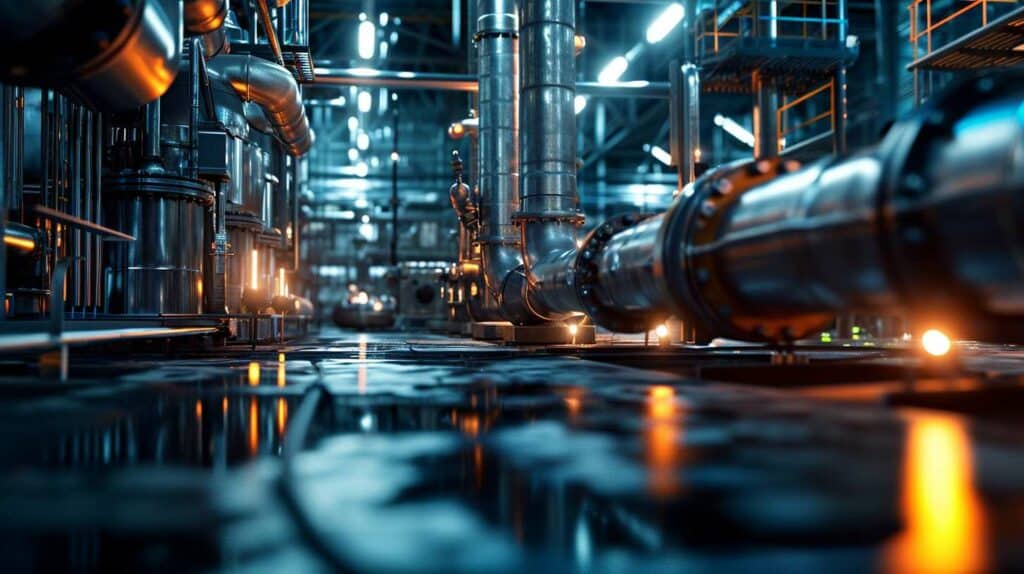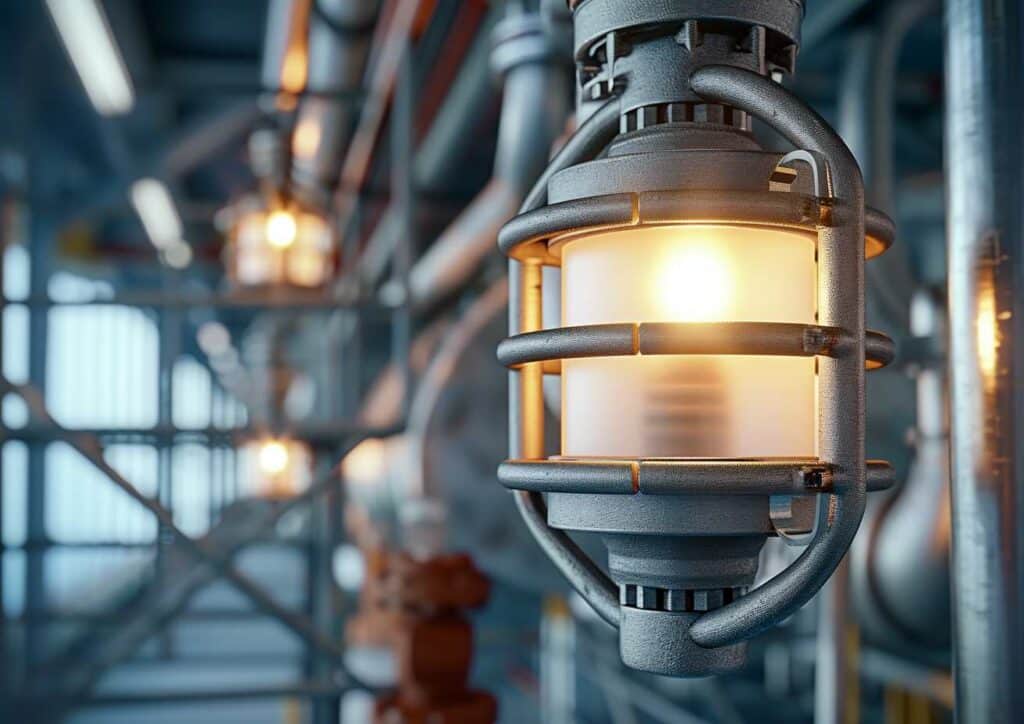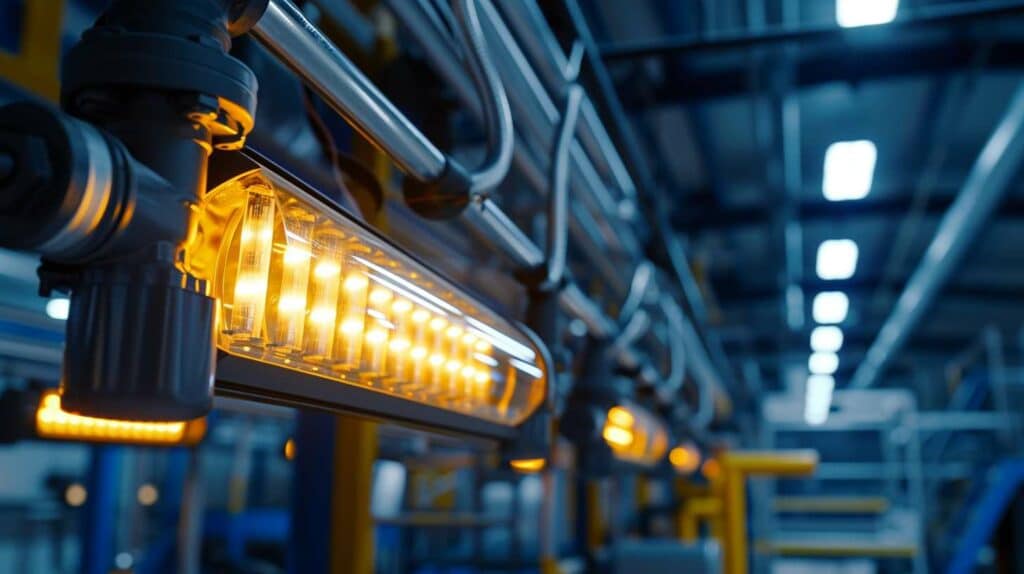Imagine entering a world where every light beam carries a weight far beyond its luminous touch. At this facility, an unspoken truth underscores the subtle hum of machinery: here, a single spark can be the line between routine and disaster. This is the reality of industries operating in hazardous environments—where explosion-proof lighting is not just a feature; it’s a vigilant guardian against the threat of catastrophe.
Understanding Explosion Proof Lighting
Explosion-proof lighting is not merely a phrase or a marketing gimmick but a lifeline for operations in volatile atmospheres. Engineers design this specialized lighting to operate safely in places where flammable gases, vapors, or dust are present, potentially leading to explosive conditions.
Have you ever wondered how a light fixture can withstand a blast and ensure the safety of an entire operation? The answer lies in the heart of explosion proof technology—a testament to human ingenuity in its relentless pursuit of safety.
What is explosion proof lighting?
“Explosion proof” does not imply that explosion proof lighting fixtures can survive an external explosion; instead, these units are designed to prevent an internal malfunction from igniting a hazardous atmosphere. This critical distinction is pivotal in industries such as oil and gas, mining, and chemical manufacturing, where the presence of dangerous compounds is part of daily operations. Manufacturers meticulously craft explosion proof lighting fixtures to contain and extinguish any sparks or flames inside the lighting fixture, preventing them from escaping and igniting the surrounding volatile environment.
How does explosion proof lighting work?
The engineering principles behind explosion proof lighting are as robust as they are ingenious. These fixtures withstand extreme conditions because craftsmen use sturdy materials and seals to create them. Inside, the electrical components are encased so that, should a fault occur, the resultant spark or hot gas is contained within the fixture. This design ensures that any potential ignition source doesn’t come into contact with the external hazardous environment, which could contain flammable gases or vapors. It’s about creating a barrier—an impenetrable fortress that guards against the smallest, potentially most dangerous, adversaries: sparks and heat.

What class is explosion proof?
To navigate the complexities of hazardous locations, experts have established a classification system that categorizes areas based on the types of flammable materials present and the likelihood of an explosive atmosphere. This system informs the design and rating of light fixtures to ensure compatibility with their intended environment.
The classification system is divided into three classes, two divisions, and subgroups:
- Class I: Locations where flammable gases or vapors are present in the air in quantities sufficient to produce explosive or ignitable mixtures.
- Class II: Environments where combustible dust is found.
- Class III: Areas where easily ignitable fibers or flyings are present but not likely to be in suspension in the air in quantities sufficient to produce explosive mixtures.
- Division 1: Where the hazardous materials are present during normal operations.
- Division 2: Where the hazardous materials are not likely present during normal operations but may exist due to accidental rupture, breakdown, or unusual equipment operation.
- Group (Class I) – For environments where flammable gases or vapors are present (Class I), the Groups categorize the types of gases and their particular hazards:
- Group A encompasses atmospheres containing acetylene, a highly flammable gas that requires robust measures to prevent ignition.
- Group B includes atmospheres containing hydrogen or gases (or vapors) of equivalent hazard, such as manufactured gas. These environments are characterized by the presence of substances that have the widest explosive range.
- Group C is designated for atmospheres containing ethyl-ether vapors, ethylene, or cyclopropane, which are slightly less hazardous than those in Group B but still require careful handling.
- Group D covers atmospheres containing gasoline, hexane, naphtha, benzene, butane, alcohol, acetone, benzol, lacquer solvent vapors, or natural gas. These are the most common materials found in many industrial settings, and the lighting for these environments must be designed to prevent the ignition of these substances.
- Group (Class II) – For places where combustible dust is the primary concern (Class II), the Groups identify the specific types of dust and their explosive characteristics:
- Group E atmospheres contain metal dust, such as aluminum, magnesium, and their commercial alloys, as well as other metals with similar hazardous characteristics. These metallic dusts can be highly combustible and, when ignited, tend to result in more severe explosions.
- Group F is reserved for atmospheres containing carbon black, coal, or coke dust, which can be explosively combustible under certain conditions.
- Group G atmospheres have dust particles from flour, starch, or grain. Although these materials may seem harmless, they can be volatile as dust accumulates and combusts explosively when suspended in the air in suitable concentrations.
Each Group within the classification system necessitates a specific design strategy for explosion proof lighting fixtures. These fixtures must prevent the ignition of gases, vapors, and dust under normal operation conditions and during equipment malfunction or abnormal operation. The careful consideration of these Groups ensures that explosion proof light fixtures are tailored to provide the utmost safety in the presence of particular hazardous materials, thereby safeguarding both the facilities and the workforce operating within them.
Technical Specifications
In the realm of explosion proof lighting, understanding the various terms and specifications that distinguish one type of protective measure from another is crucial. Two primary concepts often come up are “non-incendive” and “intrinsically safe.” Both are designed to mitigate the risk of ignition in hazardous environments, but they do so in different ways.
Comparative Analysis: Non-incendive vs. Intrinsically Safe
What is the difference between non-incendive and intrinsically safe? The key lies in their unique applications and safety features.
Non-incendive equipment is designed to prevent arcs, sparks, or heat generation under normal operating conditions. In non-incendive systems, a fault condition (like a switch closing or opening) is not capable of causing ignition. They’re typically used in Class I, Division 2, or Class II, Division 2 environments, where hazardous conditions are generally not present but may accidentally arise. Non-incendive systems are about preventing ignition during everyday operational events but are not necessarily designed to be safe under fault conditions.

Intrinsically safe equipment, on the other hand, is designed to be incapable of causing ignition in both standard and fault conditions. This is accomplished by restricting the electrical and thermal energy available for ignition to a level lower than that required to ignite the hazardous atmosphere. Intrinsically safe systems suit high-risk areas like Class I, Division 1, where explosive gases are regularly present. These systems undergo meticulous engineering to guarantee that they will not release enough energy to ignite the surrounding atmosphere, even if they fail.
Protection Mechanisms Explained
How do explosion proof lights protect against flammable gases? The answer lies in their sophisticated design features that prevent ignition sources from escaping the light fixture. These devices were created to prevent an explosion within the housing because of component failure or wiring difficulties. Here’s how they accomplish this:
- Robust Enclosures: Explosion proof light fixtures have heavy-duty enclosures capable of withstanding an internal explosion without rupturing. These objects are typically made of either cast aluminum or stainless steel, which can confine sparks and keep them from coming into contact with harmful gasses or dust in the surroundings.
- Flame Paths: One key design feature is the inclusion of flame paths. These engineered gaps in the fixture’s joints cool down the hot gases as they pass through the labyrinth-like path, preventing them from igniting the hazardous atmosphere outside the fixture.
- Sealants: The fixture securely seals all components that could generate a spark, including wiring, switches, and other electrical parts. This includes wiring, switches, and other electrical parts that could pose a risk.
- Heat Dissipation: The fixtures are designed to dissipate heat effectively so that they do not become ignition sources themselves due to high operating temperatures.
Compliance and Certifications
WattLogic possesses expertise in navigating the complex landscape of explosion proof lighting fixtures and their certifications, ensuring that all compliance measures with industry standards are met. The intricate nature of explosion proof lighting requires adherence to strict regulations and standards set by bodies such as the National Electric Code (NEC), American Petroleum Institute (API), and various international organizations like ATEX in Europe and IECEx worldwide.
WattLogic specializes in assessing a facility’s specific needs and providing lighting solutions that meet the requirements of the classification system and address Group classifications for gases and dust. Their expertise extends to securing appropriate certifications for the fixtures, which verifies that the lighting has been tested and meets the specific conditions for safe operation in hazardous environments.
By partnering with a company like WattLogic, businesses can ensure that their explosion-proof lighting fixtures are compliant and employ the highest safety and operational excellence standards. This level of diligence is essential when the stakes are as high as in hazardous location lighting, where every detail matters in safeguarding lives and operations.
Cost and Applications
For industries operating in hazardous environments, explosion proof lighting is not just an optional upgrade—it’s a vital investment in safety and efficiency. The initial cost of these specialized lighting systems can be a significant consideration for businesses, but it’s important to weigh this against the long-term savings and safety benefits.
Cost-Benefit Analysis
WattLogic’s case studies provide tangible data to support this claim. For example, GEFCO in Enid, OK, experienced substantial cost savings following a lighting retrofit. By replacing over 60 explosion-proof metal halide lights, which consumed significant energy and required frequent maintenance, with 120 watt explosion proof LED lighting, GEFCO saw a dramatic decrease in operational costs. The energy usage was reduced by more than half, as 400-watt metal halides were replaced with 120-watt LEDs. Beyond the energy savings, the longevity and reduced maintenance of LED light fixtures lessen the need for replacements and the associated downtime and labor costs.
Where is explosion proof lighting used?

Explosion proof lighting is essential in various industries where the potential for explosive environments is a constant reality. Here are a few key sectors:
- Oil and Gas: This industry, perhaps more than any other, operates in environments where flammable gases and vapors are constantly present. Explosion proof lighting is essential, not just for daily operations, but also for ensuring workforce safety.
- Pharmaceutical Production: The manufacturing of pharmaceuticals involves the use of various volatile compounds. Explosion proof lighting in these settings prevents any accidental ignition during the handling and processing of these substances.
- Chemical Processing: Chemical plants handle a plethora of reactive and flammable chemicals. Lighting in such environments must prevent any ignition while withstanding corrosive substances.
- Grain Processing and Storage: Facilities that handle grain are at high risk of dust explosions. Specialized lighting fixtures are required to handle the combustible dust effectively.
- Mining: Underground mines can contain methane and coal dust, creating a highly explosive environment that demands lighting solutions to prevent any potential ignition source.
- Petrochemical Refineries: These plants process highly flammable substances under extreme pressure and temperatures, necessitating lighting that can withstand harsh conditions without risk of ignition.
Application-Specific Considerations
When asking, “Where will the lights be used?” it’s crucial to consider the specific conditions of each environment:
- Wet Locations: In a hazardous area where moisture or direct contact with water is a concern, LED explosion proof light must also be waterproof and resistant to corrosion.
- Combustible Dust: Environments prone to accumulations of combustible dust need fixtures that can prevent any sparks or heat from escaping and igniting the fine particles.
- Flammable Vapors: In locations with combustible gases or vapors, lighting must be designed to contain and cool any potential ignition sources within the fixture itself to prevent any external explosion risk.
The case of GEFCO demonstrates how applying explosion-proof lighting in their truck paint booths—an environment with potential for flammable vapors and particulate matter—was a matter of adhering to safety standards and a wise financial decision. The tailored solution provided by WattLogic reduced the risk of ignition while offering a sustainable, cost-effective lighting solution with significant energy savings.
In conclusion, while the upfront cost of explosion proof lighting may seem daunting, the long-term benefits—both in financial savings and enhanced safety—make it a prudent investment for industries facing hazardous conditions. WattLogic’s expertise and successful case studies exemplify the tangible benefits of integrating explosion proof LED lighting solutions into high-risk environments.
Real-World Impact
The introduction of LED technology in explosion-proof lighting has revolutionized how industries approach illumination in hazardous areas. Recent advancements have made these fixtures more reliable, energy-efficient, and durable.
Technological Advancements
Innovation in LED explosion proof lighting has significantly improved energy efficiency and longevity, offering clear advantages over traditional lighting fixtures. LED lights consume significantly less energy than their incandescent or halogen counterparts — often up to 60% less. They also have a much longer lifespan, with LEDs lasting up to 100,000 hours compared to the 8,000 to 20,000 typical of traditional Metal Halide bulbs. This translates to fewer bulb changes and less downtime, an essential consideration in environments where every minute of productivity counts and maintenance can be challenging and hazardous.
Statistics supporting the shift to LED technology in hazardous environments are compelling. For instance, LED fixtures have rapidly increased efficiency, with many products achieving up to 130 lumens per watt or more. This efficiency level can result in significant cost savings over the fixture’s lifespan. Moreover, the operational temperature of LEDs is much lower than traditional lighting, reducing the risk of overheating and potential ignition in volatile atmospheres.
Safety and Efficiency
In hazardous environments, lighting does more than simply illuminate a workspace; it is integral to overall safety and operational efficiency.
Enhancing Workplace Safety
LED lighting in hazardous locations plays a critical role in accident prevention and contributes to a culture of safety. LEDs provide better-quality light with more uniform distribution, reducing shadows and improving visibility, which is essential for identifying potential risks or noticing warning signs of equipment malfunction. Furthermore, LEDs are less prone to failure, which can be particularly dangerous in an explosive atmosphere.
Employees are more aware of their surroundings and can confidently perform their tasks by ensuring that the workspace is adequately lit with reliable lighting. This minimizes the risk of accidents related to poor visibility and reinforces a company-wide emphasis on safety. The robust design of LED explosion proof lights, which includes resistance to vibration and shock, also means that they are less likely to contribute to hazardous conditions through breakage or malfunction.
Operational Efficiency
Investing in high-quality explosion-proof lighting fixtures from WattLogic can positively impact productivity and maintenance costs. The superior longevity of LED lighting means that fixtures need to be replaced less frequently, reducing maintenance requirements and the associated labor costs. This is particularly important in hazardous areas where maintenance can require shutdowns or special safety precautions, leading to potential production delays.
Additionally, the energy savings from using LED fixtures can substantially reduce operational costs over time and contribute to a lower carbon footprint—an increasingly important consideration for modern businesses. The lower heat output of LEDs also means a cooler operating environment, which can lead to less strain on climate control systems and further energy savings.
Final Thoughts
When considering hazardous environments, it is important to address the need for selecting the proper explosion-proof lighting. These specialized fixtures, particularly those harnessing the latest LED technology, are pivotal for maintaining safety and enhancing operational efficiency. Upgrading to certified explosion proof lighting transcends regulatory compliance, impacting your company’s safety protocols and financial well-being with long-term savings and a significant risk reduction. WattLogic epitomizes this commitment to safety and sustainability, offering a comprehensive portfolio of commercial LED lighting solutions catering to the unique demands of hazardous workspaces. Their dedication to providing top-tier, customized lighting options positions them as the ideal partner for businesses ready to shine a light on safety and efficiency.




